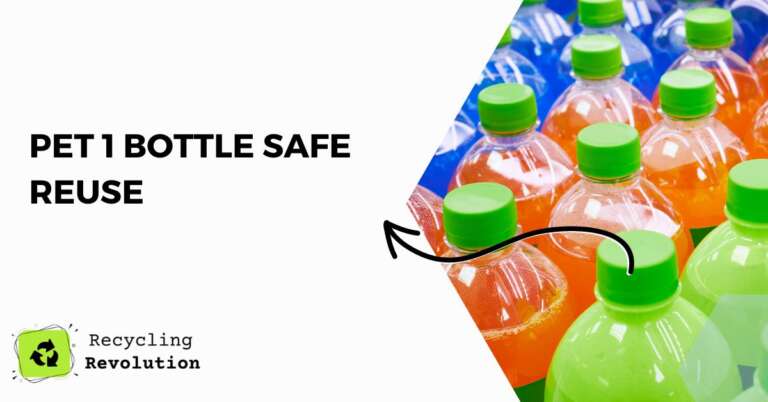Pet 1, also known as polyethylene terephthalate type 1 (PET1), is one of the most common types of plastic used for consumer products, particularly in the production of beverage bottles. In an era where sustainability and resource conservation are pivotal, reusing PET1 bottles has become increasingly relevant.
TL;DR: The practice of reusing PET 1 bottles can be both safe and ecologically beneficial if done correctly. With the right steps of cleaning, storing, and checking for wear and tear, you can safely reuse these bottles.
However, it’s essential to consider the type of liquid you’re storing, the temperature conditions, and the bottle’s physical state.
Understanding PET 1 and Its Reusability
Polyethylene terephthalate (PET or PETE) is a strong, lightweight plastic that’s recyclable. It’s designated as type 1 plastic.
PET is popular due to its transparency, lightweight characteristics, and resistance to impact, which make it ideal for packaging applications, primarily for food and beverages.
Is PET 1 Safe for Reuse?
In general, PET1 bottles are considered safe for reuse as long as they are cleaned and dried properly after every use. A bottle’s lifetime also depends on the type of beverage it was originally designed to hold.
The PET1 bottles used for carbonated drinks, for instance, are built to withstand the pressure of carbonation, making them stronger and more durable for reuse.
Considerations for Safe PET 1 Bottle Reuse
When reusing PET 1 bottles, here are a few important considerations:
- Regular Cleaning: I recommend cleaning the bottle thoroughly after each use to avoid the build-up of bacteria. Use warm water and mild detergent, ensuring the bottle is well-rinsed and air-dried before reuse.
- Inspect for Wear and Tear: Check the bottle for signs of wear, such as cracks or thinning plastic, which can harbor bacteria. If the bottle is damaged, it’s time to recycle it.
- Avoid High Temperatures: PET1 bottles should not be exposed to high temperatures like direct sunlight or a dishwasher, as they can degrade the plastic over time, potentially releasing harmful substances.
Step by Step Guide for Safe PET 1 Bottle Reuse
Here’s a simplified process of cleaning and reusing your PET 1 bottles:
- Rinse the bottle with warm water immediately after emptying it. This initial rinse helps remove any remaining liquid, which could become a breeding ground for bacteria.
- Prepare a solution of warm water and mild dish soap.
- Fill the bottle with this soapy solution and secure the lid. Shake it vigorously for a few seconds to ensure the inside is thoroughly cleaned.
- Pour out the soapy solution and rinse the bottle with clean warm water several times until no soap remains.
- Leave the bottle upside down in a dish rack or any clean surface to air dry. Ensure the bottle is completely dry before storing or reusing it.
The Diverse Uses of Reused PET 1 Bottles
While the most common use of PET 1 bottles after their initial use is for drinking, there are numerous other ways they can be reused effectively and safely. These methods not only contribute to waste reduction but also foster creativity and frugality.
Creating Home Decor
PET 1 bottles offer the perfect medium for creating unique and eco-friendly home décor items. They can be turned into flower vases, attractive centerpieces, and even Christmas tree decorations with a bit of creativity.
You can paint them, cut them into shapes, or even join multiple bottles together to create larger pieces. Always remember to clean the bottles thoroughly before using them for such purposes.
Innovative Gardening
For gardening enthusiasts, PET 1 bottles can serve as mini greenhouses for small plants, or can be used to create vertical gardens. Moreover, they can be used as bird feeders or watering systems for plants.
They’re great for starting seeds or propagating plants as well. It’s important to note that for uses that involve long-term exposure to sunlight, monitor the bottle condition closely to avoid degradation.
Utilitarian Uses
PET 1 bottles can also be turned into useful household items. These can range from storage containers for dry foods (make sure they’re sealed properly) to dispensers for liquid soaps or lotions.
They’re also great for storing homemade cleaning solutions. However, I strongly recommend marking these bottles clearly to avoid confusion with edible items.
Risks and Precautions in PET 1 Bottle Reuse
While PET 1 bottles can be reused safely with the right precautions, it’s crucial to be aware of the risks and to know when to discontinue use.
Scratches and Cracks
Scratches and cracks are not just places where bacteria can thrive, but they are also a sign that the plastic may be breaking down. Broken-down plastic can leak chemicals into the stored liquid. Thus, when a bottle shows signs of physical damage, it’s best to recycle it.
Chemical Leaching
Although PET 1 is a relatively stable plastic, it can break down over time, especially when exposed to heat and sunlight. This degradation can potentially lead to chemicals leaching into the contents of the bottle.
It’s a good practice to avoid storing PET 1 bottles in hot environments and to replace them if they’ve been left in the sun for extended periods.
Hygiene Considerations
Bacteria can build up over time in reused bottles, especially if they’re not cleaned properly or often enough. To maintain hygiene standards, regular and thorough cleaning is necessary. It’s also advisable to dedicate the bottle to a single type of beverage to prevent cross-contamination.
Enhancing Sustainability with PET 1 Bottle Reuse
Reusing PET 1 bottles not only cuts down on waste but also reduces the demand for new plastics to be produced, saving energy and reducing greenhouse gas emissions. These bottles are versatile and durable, making them suitable for a wide variety of uses beyond their original purpose.
By following the right practices and taking the necessary precautions, PET 1 bottle reuse can be a safe, effective, and eco-friendly way to reduce waste and promote sustainability.
By transforming this everyday item into something novel, we can not only extend the lifespan of the material but also kindle creativity. Let’s rethink, reuse, and recycle in our journey towards a greener and healthier planet.
Exploring Alternatives: Other Sustainable Practices
Reusing PET 1 bottles is not the only way to contribute to a sustainable lifestyle. Other measures include:
- Recycling: If the bottle is beyond its reusable lifespan, recycle it. PET1 is widely accepted in recycling programs.
- Switching to Reusable Bottles: Consider using bottles designed for prolonged reuse, such as stainless steel or glass.
Conclusion
In conclusion, PET 1 bottle reuse can be a part of our journey towards sustainable living, but it’s crucial to do so safely and responsibly. Regular cleaning, inspecting for damages, and avoiding high temperatures are fundamental aspects of safe reuse.
While reusing is beneficial, remember that each bottle has a lifespan. Beyond this point, recycling is the next best option. With conscientious practices, we can all contribute to reducing plastic waste and promoting a healthier planet.
FAQs
Is PET 1 plastic BPA-free?
Yes, PET 1 plastic is generally BPA-free. BPA is usually found in other types of plastic such as polycarbonate.
Can I store hot liquids in PET 1 bottles?
I do not recommend storing hot liquids in PET 1 bottles as heat can degrade the plastic over time.
How many times can I reuse a PET 1 bottle?
There is no set number. However, if you notice signs of wear and tear, such as cracks or discoloration, it’s time to recycle the bottle.
Can PET 1 bottles be recycled?
Yes, PET 1 is widely accepted in most recycling programs.
Note: Reusing PET 1 bottles requires careful cleaning and inspection. Always prioritize your health and safety when choosing to reuse these bottles. If in doubt, recycle the bottle or use alternatives designed for prolonged reuse.

